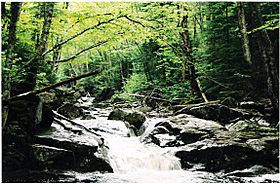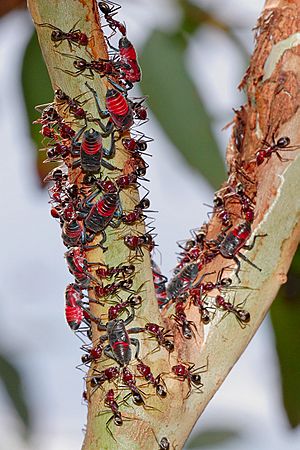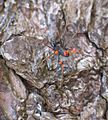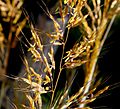Ecology facts for kids
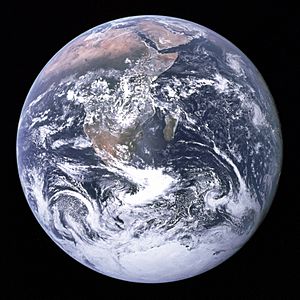 |
|
 |
|
|
Ecology is the science that studies living things, their surroundings, and how they interact. The word 'ecology' comes from two Greek words: oikos (meaning 'house' or 'home') and logos (meaning 'study'). So, it's like studying Earth's home!
Ecology is all about ecosystems. Ecosystems are like a giant web of connections between all living things and their environment. Since ecology covers all kinds of biodiversity, scientists called ecologists study everything. This ranges from tiny bacteria that help nutrients cycle, to how huge rain forests in the tropics affect the Earth's atmosphere.
Today, ecologists often focus on land regions and climate change. Ecology has many real-world uses. It helps with conservation (protecting nature), managing wetlands, and handling natural resources. This includes agriculture, forestry, and fisheries. It also helps with city planning (urban ecology), community health, and economics. Ecology gives us a way to understand how humans interact with nature.
Contents
- What are the Levels of Ecology?
- Related pages
- Images for kids
- See also
What are the Levels of Ecology?
Ecology looks at many different levels of life. These levels range from very small things, like cells, to huge things, like the entire biosphere (all life on Earth).
What is Biodiversity?
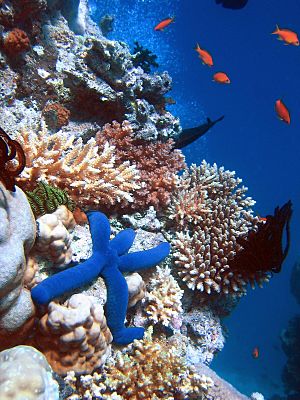
Biodiversity is short for "biological diversity." It means the huge variety of life on Earth. This includes everything from different genes to different ecosystems. Biodiversity can be measured in many ways. It includes species diversity (different kinds of living things), ecosystem diversity (different types of environments), and genetic diversity (differences within a species).
Scientists want to know how this diversity affects the complex processes in nature. Biodiversity is very important for ecosystem services. These are the benefits nature provides that keep humans healthy and improve our lives. Stopping species extinctions is one way to protect biodiversity. This means protecting genetic variety, habitats, and the ability for species to migrate. Understanding biodiversity helps people plan how to protect species and ecosystems.
What is a Habitat?
A habitat is the natural home or environment where a species lives. It's the kind of place where a certain group of living things is found. Habitats can be defined by many things. These include living factors (like food) or non-living factors (like elevation). For example, a habitat could be an aquatic (water) or terrestrial (land) environment. It might be a mountain or alpine area.
Sometimes, species change their habitats. This can happen when one group of animals competes with another. For example, a type of tropical lizard might have a flatter body if it lives in rock cracks. This helps it hide better than lizards in open areas. Habitat changes also happen when animals like amphibians or insects grow up. They might start in water and then move to land.
Some species are called ecosystem engineers. They change their environment in a specific area. For example, beavers build dams. This changes water levels and improves their habitat.
What is a Niche?
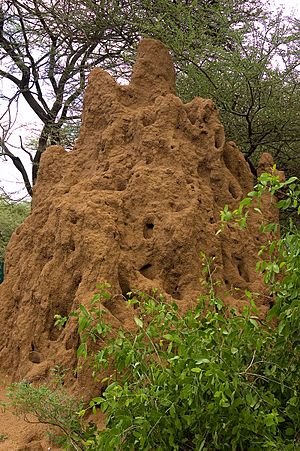
Every species has special features that help it fit into its ecological niche. A trait is a measurable feature of an organism. It can affect how well the organism survives. Genes play a big role in how these traits develop and appear. Species that live in an area develop traits that help them deal with their local environment. This gives them an advantage over other similar species.
The competitive exclusion principle says that two species cannot live in the same place forever if they need the exact same limited resource. One species will always be better at getting that resource than the other.
How Do Organisms Change Their Niche?
Organisms are affected by their environment, but they also change it. This back-and-forth effect between organisms and their environment can change conditions. These changes can be local, like a beaver pond. They can also be global, like how plants affect the air. These changes can last even after an organism dies, like decaying logs.
The idea of ecosystem engineering is similar to niche construction. Ecosystem engineering is about physical changes to the habitat. Niche construction also looks at how these physical changes affect evolution. It also considers how these changes create a feedback loop for natural selection. Ecosystem engineers are organisms that change the availability of resources for other species. They do this by changing the physical state of living or non-living materials. This way, they create or change habitats.
What is a Biome?
Biomes are large areas of Earth's ecosystems. They are grouped mainly by the type of plants that grow there. These plant types are limited by things like climate, rainfall, and weather. Examples of biomes include tropical rainforests, temperate deciduous forests, taiga, tundra, and hot deserts.
Recently, scientists have also identified other biomes. These include the human and oceanic microbiomes. To a microbe, the human body is like a habitat and a landscape. Microbiomes were found thanks to new tools in molecular genetics. These tools showed how much hidden microbial diversity there is on Earth. The oceanic microbiome is very important for the chemistry of the planet's oceans.
What is the Biosphere?
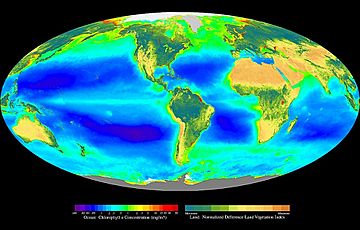
The largest level of ecological organization is the Biosphere. This is the total sum of all ecosystems on Earth. Ecological relationships control the flow of energy, nutrients, and climate across the whole planet. For example, the amount of CO2 and O2 in Earth's atmosphere has changed over time. This is because of gases released by living things through breathing and photosynthesis.
Ecological ideas have also been used to explain how the planet regulates itself. For instance, the Gaia hypothesis suggests that living organisms create a feedback loop. This loop helps keep Earth's temperature and atmosphere stable within a certain range.
Individual Ecology
Understanding the traits of individual organisms helps explain patterns at other levels. This includes populations, communities, and ecosystems. Traits can be things like how old an organism is when it can reproduce, how long it lives, or how much energy it uses for reproduction. Other traits might be physical, like the spines on a cactus. They can also be behaviors, like how animals court each other.
Organisms' traits can change through getting used to an environment, developing, and evolving. This is why individual organisms are a key focus for both ecology and evolutionary ecology.
Population Ecology
Population ecology studies how populations of species change over time. It also looks at how these populations interact with their environment. A population is a group of individuals of the same species. They live, interact, and move through the same niche and habitat.
Metapopulations and Migration
When individuals move, they are called emigrants (when they leave an area) or immigrants (when they enter an area). Places where ecologists study populations are called sites. Some sites are "source patches." These are productive places that create young animals that move to other areas. Other sites are "sink patches." These places only receive migrants. The population there would disappear if new individuals didn't arrive, or if conditions didn't improve.
Metapopulation models look at how these patches change over time. They help answer questions about where populations are located and how they grow. The ecology of metapopulations is a process of local extinctions and new colonizations. Small, less good patches are kept alive by new immigrants. A metapopulation structure can change year to year. Some patches might be sinks in dry years but sources when conditions are better. Ecologists use computer models and field studies to understand metapopulation structures.
Community Ecology
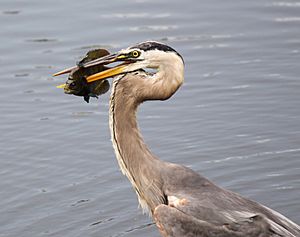
Community ecology studies how different species interact when they live in the same area. Community ecologists look at what causes patterns and processes for two or more interacting species. For example, research might measure species diversity in grasslands based on soil richness. It could also look at how predators and prey interact. Or it might study competition between similar plant species, or helpful interactions between crabs and corals.
Ecosystems can be habitats within biomes. They form a complete system that responds to changes. This system has both physical and living parts. Ecosystem ecology is the science of figuring out how materials (like carbon or phosphorus) move between different parts. These parts could be tree biomass or soil material. Ecosystem ecologists try to find the reasons behind these movements.
What are Food Webs?
A food web is a classic example of an ecological network. Plants capture solar energy and use it to make simple sugars during photosynthesis. As plants grow, they gather nutrients. Then, plant-eating animals called herbivores eat them. This transfers energy through a chain of organisms as they eat each other. A simple, straight feeding path from a basic plant to a top consumer is called a food chain. The larger, connected pattern of food chains in a community creates a complex food web. Food webs are like maps that show how energy and materials flow.
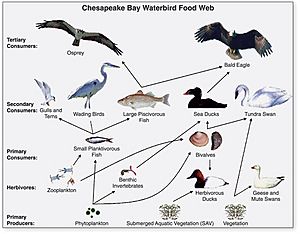
Food webs are often simpler than what happens in the real world. It's hard to measure every single connection. Scientists usually study food webs in a specific habitat, like a cave or a pond. Then, they use what they learn to understand bigger systems. Figuring out what animals eat often means studying their stomach contents. This can be hard. Or, scientists can use special chemical traces to follow how nutrients and energy move through a food web. Even with these challenges, food webs are still a valuable tool to understand ecosystems.
Food webs show how complex relationships emerge. Some species, like omnivores, have many weak feeding links. Others are more specialized with fewer, stronger links. Studies show that food webs have patterns of a few strong links and many weak ones. This helps ecological communities stay stable over time. Food webs are made of smaller groups where members are strongly connected. Weaker connections happen between these groups. This makes the food web more stable.
What are Trophic Levels?
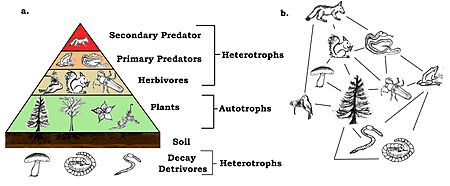
A trophic level is a group of organisms that get most of their energy from the level below them. Links in food webs mainly show feeding relationships between species. The variety of life in ecosystems can be organized into trophic pyramids. The vertical part of the pyramid shows feeding relationships, moving up from the base of the food chain to top predators. The horizontal part shows the amount or living material at each level. When the amount of each species is put into its trophic level, they naturally form a 'pyramid of numbers'.
Species are generally put into three groups: autotrophs (or primary producers), heterotrophs (or consumers), and Detritivores (or decomposers). Autotrophs make their own food using photosynthesis or chemosynthesis. Heterotrophs must eat other organisms for food and energy.
Heterotrophs can be divided further:
- Primary consumers are strict plant-eaters.
- Secondary consumers are carnivorous predators that only eat herbivores.
- Tertiary consumers are predators that eat both herbivores and other predators.
Omnivores don't fit neatly into one group because they eat both plants and animals. It's thought that omnivores have a bigger impact as predators than as plant-eaters.
Trophic levels are part of looking at ecosystems as whole or complex systems.
What is a Keystone Species?
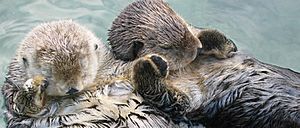
A keystone species is a species that is connected to a very large number of other species in the food web.
Sea otters are often given as an example of a keystone species. This is because they control the number of sea urchins that eat kelp. If sea otters are removed, the urchins eat all the kelp beds. This has a huge effect on the whole community. For example, hunting sea otters is thought to have led to the extinction of the Steller's sea cow.
While the keystone species idea is used a lot in conservation, some people say it's not clearly defined. It's hard to figure out which species might be a keystone species in every ecosystem. Also, food web theory suggests that keystone species might not be very common. So, it's not clear how widely this idea can be used.
Behavioural Ecology

All organisms show behaviors. Even plants have complex behaviors, like memory and communication. Behavioural ecology is the study of how an organism acts in its environment. It looks at the ecological and evolutionary effects of these actions. Ethology is the study of observable movements or behaviors in animals.
Adaptation is the main idea in behavioral ecology. Behaviors can be seen as traits and passed down, just like eye color. Behaviors can evolve through natural selection. They become useful traits that help an organism survive and reproduce better.
Predator-prey interactions are a basic concept in food web studies and behavioral ecology. Prey species can show different behaviors to predators, like avoiding them, running away, or defending themselves. Many prey species face several predators that pose different levels of danger. To adapt to their environment and face threats, organisms must balance their energy. They invest energy in different parts of their life, like growing, feeding, mating, socializing, or changing their habitat.
Leafhoppers (Eurymela fenestrata) and ants (Iridomyrmex purpureus) have a symbiotic relationship. The ants protect the leafhoppers from predators. In return, the leafhoppers, which feed on plants, release a sweet liquid called honeydew from their bodies. This honeydew gives energy and nutrients to the ants.
Related pages
Images for kids
-
Long-tailed broadbill building its nest
-
Bumblebees and the flowers they pollinate have coevolved so that both have become dependent on each other for survival.
-
The leaf is the primary site of photosynthesis in most plants.
-
The architecture of the inflorescence in grasses is subject to the physical pressures of wind and shaped by the forces of natural selection facilitating wind-pollination (anemophily).
-
The layout of the first ecological experiment, carried out in a grass garden at Woburn Abbey in 1816, was noted by Charles Darwin in The Origin of Species. The experiment studied the performance of different mixtures of species planted in different kinds of soils.
See also
 In Spanish: Ecología para niños
In Spanish: Ecología para niños


